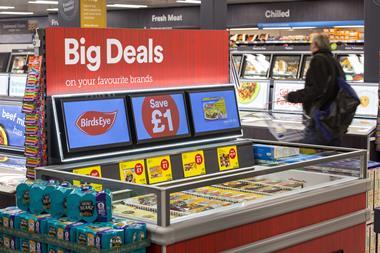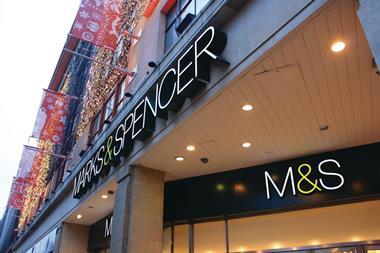A better shopper experience might make Marks & Spencer store closures less likely.
M&S’s property review will reveal how many – if any - of its 343 full-line stores chief executive Steve Rowe intends to cut.
But however many branches the retail giant is left with, improvements are needed to improve the customer experience in-store. Here are four ways M&S could improve its shops.
Sharper merchandising
“M&S have not changed things that much since the mid-2000s,” says Haitong analyst Tony Shiret. “They have started to experiment with layout a bit but only in some stores. In Westfield Stratford they have a lot more tables and more substantial, structured fixtures, which allow more of a display.”
That approach contrasts with M&S’ more typical merchandising racks of clothing.
Shiret observes: “Tables need a lot of labour to keep in shape but they sell better than hanging because items are more visible to the customer.”
He gives the example of Inditex jewel in the crown Zara, which uses tables a lot.
“Zara’s shopfit looks expensive and M&S looks DIY in comparison,” he maintains. “It doesn’t look exciting. Part of the attraction of Zara is that you feel like you’re getting something cheap in an expensive shop.”
Visual Thinking managing director Karl McKeever points to M&S’ failure to successfully distinguish between its sub-brands.
“One of the things they did do quite successfully was their programme of internal sub-brands,” he says. “Within those there was a focus on customer experience. Autograph had elevated styling, Per Una had to head to toe coordination.
“But that doesn’t happen anymore. They haven’t kept up their training of in-store colleagues and you now fail to see the differences between what brands are saying if you walk through.
“If they intend to have brands with meaning they need to treat them like brands in own right.”
Enhanced customer service
Some critics say that M&S’ shop floor staff are spread too thinly.
“They seem to concentrate staff at key points,” says McKeever. “Cash desks, fitting rooms - and more often than not they will be multitasking at those points. That means that the service points become a mess of hangers and returned product.
“There are not the general people there during the day, tidying and picking stiff up on the floor. All the good work is done overnight and that’s fine for customers who shop early in the day. But the rest of the day sees declining standards.”
While Shiret concedes that M&S’ shop floor staff can be difficult to find, he disagrees that M&S’s customer service needs vast improvement. Instead, he believes the retailer has missed opportunities elsewhere.
“M&S customer service is generally reasonable,” he says. “Their assistants tend to be longer serving and more mature. But I think they missed a trick on deploying tech to improve customer service. They’re not in the dark ages, but are still catching up.
“A year ago they shelved some of the technology they were going to put in to improve stock availability. We are sold these ideas as if they are future and then suddenly M&S don’t think they need it after all.”
M&S’ stock availability could also be better. Despite acknowledging improvement, Shiret believes that it has further to go, especially in popular sizes.
“Size 10 in particular is still a difficult size to find after two weeks into the season,” he says.
Opportunity in concessions and beauty
M&S has made strides in beauty but perhaps not enough compared to the department stores of retailers such as Debenhams and John Lewis.
In its half-year results in April, Debenhams highlighted beauty as a stand-out category and it aims to drive more of its revenue through the category.
Debs is now front-of-mind for many beauty brands looking to launch in the UK such as cult American label Kat von D, which launched exclusively with the retailer.
John Lewis too sees greater opportunity in beauty. When he revealed the latest investment in the category, John Lewis buying director for fashion and beauty Ed Connolly said: “Beauty is one of the best performing categories at John Lewis and a significant footfall driver, so this investment is a reflection of our ambition in this space.”
Beauty could be an ideal entry category for M&S to test the waters when it comes to concessions. While the knee-jerk reaction to the idea of M&S having concessions might be negative, it is, some experts feel, an idea worth exploring.
Haitong’s Shiret says: “What Debenhams is doing with their space revamp programme gives you an idea of how other retailers are thinking.
“Maybe you could have that with M&S, develop stores within stores. But my view is that something more dramatic is required. Fundamentally, all this needs to be in a smaller space. There is no getting away from that.”
Liberum’s Tom Gadsby is less optimistic about M&S’ chances of developing a successful concession offering but agrees with Shiret on store closures. “Topshop isn’t a bad brand and they brought it into BHS stores and it didn’t work, did it?”
“Look at what Dixons did, closed half their space and increased their market share. There is no way M&S can do that but they need that moment, they need to cut stores.”
Consistency across the estate
One of M&S’ greatest challenges is to present a common front to its customers. While the issue of certain lines only being available in a limited number of stores has sometimes been identified as a problem, a less discussed but equally problematic issue is the disparity between branches.
Many retailers face a similar problem: if a business has a large number of stores then a refit programme often takes years and the initial refits begin to look tired once the final ones are completed.
But with M&S’, the problem is more acute. “Their new stores, from a design perspective, are higher quality,” says McKeever. “And there is a credible attempt at merchandising. But the majority of shops are massive old stores which have only had cosmetic treatment for decades.”
He points a store poll Visual Thinking undertook in the Midlands. “Six stores were either new or had been rebuilt but 25 stores were from the 1960s or earlier and had not been fundamentally changed.
“And they are huge properties in key areas - Leicester and Nottingham city centres for instance - meaning that their biggest competitor a few doors down, Next, beats them hands down in terms of environment.”
What M&S could do with, critics agree, is a period of stability.
“I am surprised that more shareholders aren’t more vocal about the needless and constant changes, which have little to no return on investment,” asserts McKeever. “It is schizophrenic and customers are as confused as management are. They need to bed changes in and not alter them for a few years.”
Shiret is equally weary. “I sense that whatever they try this year, they will be trying something different next year,” he says.
But if M&S can consistently improve its in-store proposition, perhaps the size of its estate would be less of a headache for Rowe than many believe it is at present.


























4 Readers' comments